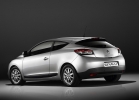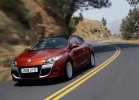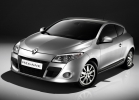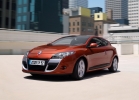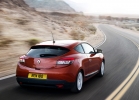Test drive by Renault Megane compartment since 2008 compartment
Comprehensive test: Ford Focus RS, Renault Megane, Mitsubishi Evo X
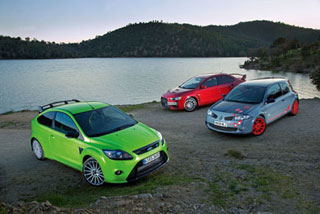 The new Ford Focus RS fights on the spot, but is it enough to defeat the uncompromising Renault Megane R26R and an all -wheel drive Mitsubishi Evo X?
The new Ford Focus RS fights on the spot, but is it enough to defeat the uncompromising Renault Megane R26R and an all -wheel drive Mitsubishi Evo X? Sometimes evolution gives rise to real monsters, and it seems that this is exactly what happens in the class of hot hatchbacks. The latest Focus RS raised the Power Power Power of the front -wheel drive confirmations to a sky -high altitude, and for him and his competitors today it is only to come up with a separate genre, because these are no longer lighters in the guise of family small studies, but a much more serious equipment.
And let the presence of Mitsubishi Lancer Evolution X in this test are not embarrassed. The days passed when in the hierarchy of sports cars EVO, along with his sworn rival, Subaru Impreza Sti stood a step above the hot hatchbacks thanks to the sedan and a rally genealogy. Today, the inter -class boundaries are erased, and buyers of sportsmen often consider EVO as an alternative to hot hatchbacks, and vice versa.
With Renault Megane R26R, everything is not so simple. This native of the class of hot hatchbacks is trying with all his might with his past and, I must say, was very successful in this. The most extreme Megane lost its rear seats and sound insulation, and in return received plastic windows, a security frame, a titanium exhaust system and extreme Toyo Proxes R888. On the TOYO website, these tires are listed in the Motorsport section, and in the description of the model there is a warning about increased caution when driving along a wet road due to limited resistance to aquaplanging. As they say, the comments are unnecessary.
What is the trick?
Fortunately, my colleagues did not hit the rain on the way to the south of France, where I was waiting for them on Focus RS, but even without it their path was not easy. The voracious Evo required refueling almost every half an hour, and the devoid of the Renault stereo system caressed the driver’s hearing with the noise of tires and the engine.
 Ford argues that such suffering does not threaten the owner of Focus RS. This is RS, ”says the chief of the sports unit of the company Yost Kapito,“ but he remains Focus. ” RS is built on the basis of Focus ST - one of the best hot hatchbacks in the market. The novelty almost completely borrowed the salon from the younger model (with the exception of the details of the design and new seats that perfectly fix the body), and even the steering wheel remained the same, but the KP lever became shorter (the insides of the gearbox has changed a little). The front -wheel drive, contrary to expectations, did not give way to complete, and under the hood, RS settled for 305 hp. The version of the 2.5-liter turbine from ST. Work on the motor was not limited to the reprogramming of the brain - it received new pistons, camshafts and connecting rods, as well as a more powerful turbine and other attachments.
Ford argues that such suffering does not threaten the owner of Focus RS. This is RS, ”says the chief of the sports unit of the company Yost Kapito,“ but he remains Focus. ” RS is built on the basis of Focus ST - one of the best hot hatchbacks in the market. The novelty almost completely borrowed the salon from the younger model (with the exception of the details of the design and new seats that perfectly fix the body), and even the steering wheel remained the same, but the KP lever became shorter (the insides of the gearbox has changed a little). The front -wheel drive, contrary to expectations, did not give way to complete, and under the hood, RS settled for 305 hp. The version of the 2.5-liter turbine from ST. Work on the motor was not limited to the reprogramming of the brain - it received new pistons, camshafts and connecting rods, as well as a more powerful turbine and other attachments. The changes affected the body. Wings with extended wheel arches hide the rut that increased by 40 mm, the slots in the body panels help to more effectively cool the engine, and the elements of aerodynamic plumage (front spoiler, rear diffuser and anti -wing) create additional clamping force. True, how great it is, Ford is not specified, so you should not wait for miracles from the aerodynamics of Focus RS.
Snob pressed to the land of RS (it is 20 mm below ST) will seem like a caricature on a sports Ford, which can not be said about Renault. R26R painted in a formidable dark gray color with carbon hood and red wheeled disks looks more seriously and looks like a real racing apparatus. And even such an important attribute of a sports car as exhaust pipes, Megane is deprived of shocking - unlike defiantly wide exhaust bells on RS.
But what about Mitsubishi Evo X? Against the background of the evil Ford and Renault, it seems almost an ordinary car, although the technical filling is also very serious here. The two -liter Evo turbo engine develops 295 hp, yielding to Focus only 10 horses. Megane at first glance is much weaker - only 230 hp, but this is a deceptive impression. With mass 1230 kg
 this car is 125 kg easier than a standard R26, and for Focus and Evo it wins and more - 237 and 330 kg, respectively.
this car is 125 kg easier than a standard R26, and for Focus and Evo it wins and more - 237 and 330 kg, respectively. While my colleagues rushed through all of France on Mitsubishi and Renault, I managed to get acquainted with Focus RS. From the very first minutes, the car struck me with its unexpectedly noble tidy. The suspension of RS is noticeably tougher than that of ST (behind - 40%!), But this does not prevent the car from perfectly smooth out the flaws of the road surface. My surprise was replaced by enthusiasm when it turned out that the stabilizers of the reptable stability of RS in the RS are the same as that of the 2006 Focus WRC rally in the asphalt calculation.
Powerful front -wheel drive cars inevitably have the so -called parasitic steering of the front wheels under the thrust, and Focus RS, despite all the tricks of Ford engineers, is not deprived of this deficiency. Revoknuckle front suspension, designed specifically for RS, has reduced the distance between the wheel rotation axis and its geometric center. The smaller this distance, the smaller the so-called shoulder of the running-in, that is, the lever, on which the very force acts, because of which the front of the front-wheel drive car strives to break out of the hands when the gas pedal presses. The Revoknuckle system allows you to reduce this distance by about two -thirds. That's the whole focus. By the way, a similar design is also used on Megane R26R.
RS engine and transmission are distinguished by the same delicacy as the suspension. Despite the high degree of crossing of the motor, it remains soft and flexible, although in his hissing turbine and exhaust claps you can think that an indomitable monster is hiding under the hood. At least when I parked the Focus RS next to the Megane R26R and Evo X, the sound accompaniment was delighted with my colleagues who were waiting for me on the Kol-de-Vlens mountain pass.
On high
Here, in the Alps, any road will make the heart of a sophisticated driver be fought quickly, but even among this splendor, we found something special - a special facple of the Monte Carlo rally. For 5 km of highway, in a devilish dance, it loopes along the mountain slopes, demanding the driver and his car maximum dedication.
After a series of races there and back, I come to the conclusion that EVO X, despite its four -wheel drive transmission, causes the most complaints in these specific conditions. Its creators were clearly overdue with sports. The pleasure of excellent coating clutch, impressive dynamics and magnificent reactions to the steering wheel spoils the hard suspension. In an effort to tell the driver about all the features of the asphalt under the wheels Evo unpleasantly shudders on potholes and jumps on irregularities. Yes
 the steering, with all its severity, accuracy and competently selected effort, does not please the feedback. The sixth generation is considered to be a reference EVO of EVO in this regard.
the steering, with all its severity, accuracy and competently selected effort, does not please the feedback. The sixth generation is considered to be a reference EVO of EVO in this regard. To fully use the outstanding abilities of Mitsubishi, you need a racing track. Only there you can afford to enter the turn on braking, provoke the skid of the rear axle and give full gas, straightening the trajectory. But on the usual road, such tricks are too complex and unsafe, and without them the charm of Evo X is rapidly fading. An unpretentious interior (although the seats are very convenient), the boring sound of the motor (but a very clear CP mechanism) and the cotton brake pedal complement the picture.
The Megane R26R is not as fast as Evo X, in a straight line, but in terms of controllability it is not inferior to it, but what is superior to it. You can’t call Renault the Renault suspension, however, it copes with irregularities more effectively than EVO: where the tires break off the asphalt on Mitsubishi, R26R maintains coating contact. Undoubtedly, racing rubber, as well as low unsubstantiated masses, contribute to the business. Thanks to this, the R26R wheels respond faster to the profile of the road and transmit less vibrations to the body.
Modern Renaults do not differ in stunning information content of steering, and R26 is no exception. Despite the very obedient chassis, the steering wheel is too light here, although compared to other brand models, it allows you to more accurately direct the car to the desired trajectory. The two -axle front suspension design reduces the parasitic strokes under the thrust, but even the additional assistance of the differential of high friction, which jugles the torque between the front wheels, does not allow to completely eliminate the light twisting of the steering wheel.
The tires in which the R26R are shod, provide an impenetrable grip on dry asphalt. Perhaps even Evo does not keep the way as good as Renault. Only with rough operation of the gas pedal at the exit of the turn, you can tear the front wheels in sliding, provoking insufficient rotation.
Under the evil roar of the titanium exhaust system R26R, it accelerates with lightning speed and storms turns. This is undoubtedly one of the best front -wheel drive cars in history. If I had been sentenced to the front drive for life, I would have changed this Megane perhaps to the old Honda Integra Type R. or to the new Focus RS?
Quick and good
After Renault Ford, at first it seems like a completely different breed by a car. It is clearly heavier and more solid, but the most powerful engine quickly nullifies all the suspicions of the slowness of RS. The acceleration pairs are enough to come to the conclusion that it is Focus that is the fastest car in this trio. And the front wheels surprisingly easily cope with the onslaught of 305 horses. Only in the I gear there is a small slip, and for some reason parasitic strokes under the traction do not appear more strongly when turning the steering wheel, but in the near-headed zone. On the first generation RS there was a differential of high friction, thanks to which the car could literally be tightened into a turn using a gas pedal. The new RS is not capable of this, and the differential here muffles the return movement of the steering wheel, so that the steering wheel has to be returned with effort to zero position when leaving the turn. Focus steering is heavier than Megane, and this favorably affects its information content. In addition, the help of the steering wheel amplifier can be adjusted: in the Comfort mode, the steering wheel becomes as easy as possible, and when moving to Normal and further to Sport, the force on the steering wheel and, as a result, the feedback increases.
 If the front wheels solve the front wheels and the behavior of the machine depends only on them, then the Focus in turns seems to rotate around the vertical axis passing through the center of the car. Therefore, on the R26R, provoking the sliding of the front wheels is much easier than the rear of the rear, and in RS the controllability is more neutral. Representatives of the Ford have not yet unveiled the RS time on nurging, but they argue that the novelty passes the circle faster than Renault, the result of which is 8 min 17 p. This is similar to the truth, since the engine power on the northern loop is very important, and, despite the exclusively tenacious Magane chassis, on the straight line Focus is noticeably faster. RS also copes with poor asphalt more than worthy. And although Ford, unlike Renault, does not seem that the car is literally glued to the road, Focus does not storm the irregularities, like Megane, but skillfully dissolves them in the bowels of the suspension thanks to the perfectly selected stiffness of shock absorbers. In general, the RS chassis, of course, is not as informative as the R26R, but for high -speed driving this is not a hindrance.
If the front wheels solve the front wheels and the behavior of the machine depends only on them, then the Focus in turns seems to rotate around the vertical axis passing through the center of the car. Therefore, on the R26R, provoking the sliding of the front wheels is much easier than the rear of the rear, and in RS the controllability is more neutral. Representatives of the Ford have not yet unveiled the RS time on nurging, but they argue that the novelty passes the circle faster than Renault, the result of which is 8 min 17 p. This is similar to the truth, since the engine power on the northern loop is very important, and, despite the exclusively tenacious Magane chassis, on the straight line Focus is noticeably faster. RS also copes with poor asphalt more than worthy. And although Ford, unlike Renault, does not seem that the car is literally glued to the road, Focus does not storm the irregularities, like Megane, but skillfully dissolves them in the bowels of the suspension thanks to the perfectly selected stiffness of shock absorbers. In general, the RS chassis, of course, is not as informative as the R26R, but for high -speed driving this is not a hindrance. However, as practice shows, speed and pleasure are far from identical. Focus can proudly wear the title of the fastest front-wheel drive car in the world, and among 4-seater hot hatchbacks it is currently the best. But if you need the best car for pleasure, you will have to come to terms with the fact that it will be 2 -seater - such as Megane R26R.
 Technical characteristics Ford Focus RS
Technical characteristics Ford Focus RS Dimensions, mm
4402x1842x1497
Equipped mass, kg
1467
engine's type
gasoline L5 with turbocharged
Working volume, cubic meter. cm
2522
Max. Power, L.S./rpm
305/6500
Max. moment, nm/rpm
440/2500-4500
Transmission
mechanical 6-speed
Drive unit
front
Max. speed, km/h
263
Acceleration time 0100 km/h, with
5,9
Fuel consumption (average), l/100 km
9,4
 Technical characteristics of Renault Megane R26R
Technical characteristics of Renault Megane R26R Dimensions, mm
4505x1810x2650
Equipped mass, kg
1635
engine's type
gasoline L4 with turbocharged
Working volume, cubic meter. cm
1998
Max. Power, L.S./rpm
295/6500
Max. moment, nm/rpm
366/3500
Transmission
mechanical 5-speed
Drive unit
full
Max. speed, km/h
240
Acceleration time 0100 km/h, with
5,4
Fuel consumption (average), l/100 km
10,4
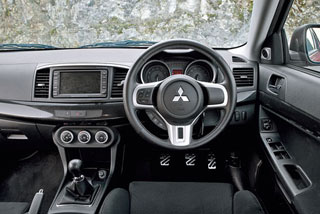 Technical characteristics of Mitsubishi Evo X
Technical characteristics of Mitsubishi Evo X Dimensions, mm
4228x1777x2617
Equipped mass, kg
1230
engine's type
gasoline L4 with turbocharged
Working volume, cubic meter. cm
1998
Max. Power, L.S./rpm
230/5500
Max. moment, nm/rpm
310/3000
Transmission
mechanical 6-speed
Drive unit
front
Max. speed, km/h
237
Acceleration time 0100 km/h, with
6,0
Fuel consumption (average), l/100 km
8,5
Matt Pryor
Photo by Stan Papiore
Haymarket Magazines Ltd, Autocar
A source: Avtopanorama magazine

